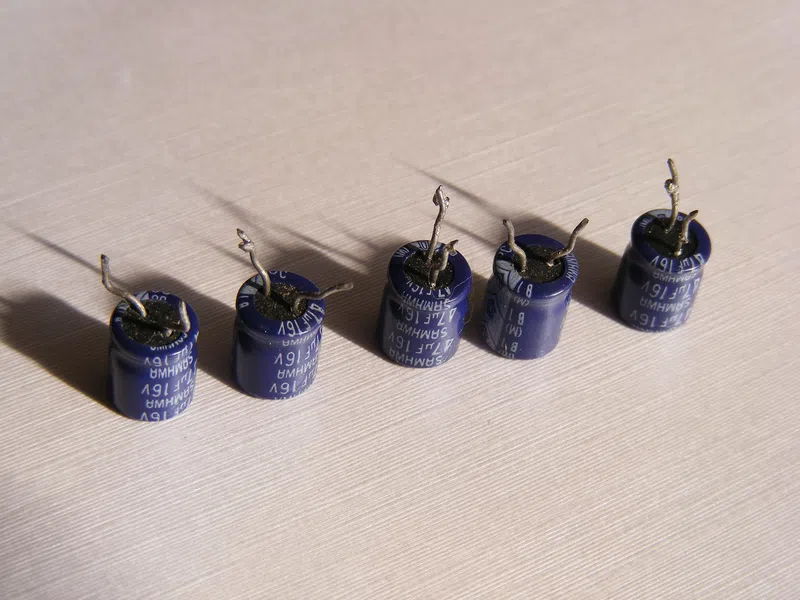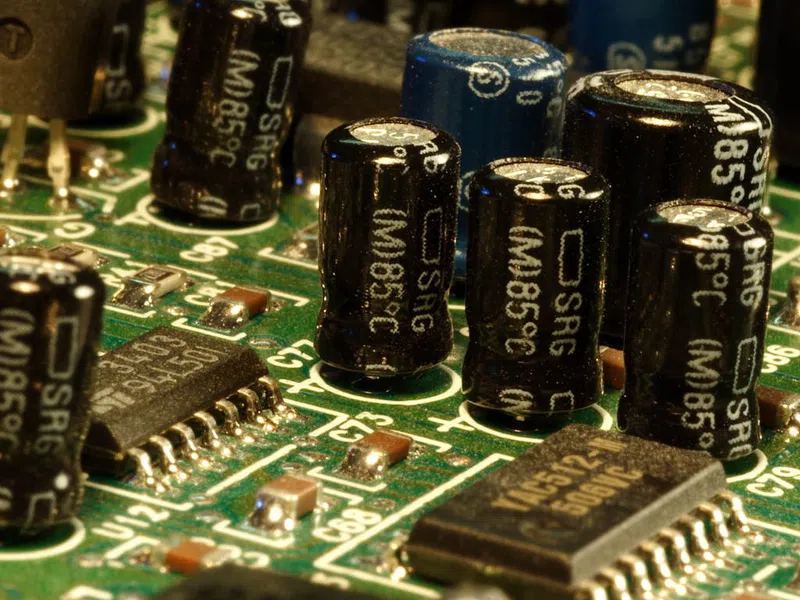However, while that is the case, the difference is that a battery stores energy in the form of chemical potential, whereas capacitors store energy in the form of electrical potential. Also, the leakage current is higher in capacitors than in batteries, which means that capacitors cannot hold a charge as long as batteries do.

Capacitors.
The fast movement of electrons between the two plates of a capacitor makes it very useful in electronic applications.
Capacitor
Inside a capacitor, there are two metal plates made of a conductive material such as aluminium. These plates are separated by an insulating material, also known as a dielectric.
Before we explore how a capacitor works, we need to understand the concept of polarisation.
A dielectric consists of lots of polar molecules that have both a positive and a negative end. When no charge is stored by the capacitor, there is no electric field, and these molecules randomly point in different directions.

Figure 2. Random molecules (top) and molecules in an electric field (bottom). Source: hyperphysics, Wikimedia Commons (Public domain).When a voltage is applied to a capacitor, an electric field is generated. The positive ends of the molecules are attracted to the negatively charged plate and vice versa.
As the dielectric is an insulator and the molecules cannot shift, the polarised molecules orient themselves in such a way that opposite charges on the molecules and the plates face each other.

Figure 3. Orientation of polarised molecules in an electric field. Source: Brews ohare, Wikimedia Commons (CC BY-SA 3.0).As the electric field of the polarised molecules is in the opposite direction to the capacitor plates, the potential difference is reduced, and the capacitor’s capacity to store charge per unit potential difference is increased.
Take a battery and attach the negative end to the negative terminal of the capacitor (indicated by a strip) and the positive end to the positive terminal. However, bear in mind that not all capacitors have marked poles. If that is the case, they can be connected in whatever direction in the circuit.

Figure 4. Symbol of a capacitor. Source: Wikimedia Commons (Public domain).The charges flow from the battery to the negative terminal of the capacitor and from the positive plate to the positive end of the battery.

Figure 5. The diagram shows how the voltage across the plates and the current flow into the plates vary as the capacitor charges. Source: jjbeard, Wikimedia Commons (Public domain).Once the charges have flown from the positive plate to the battery and from the battery to the negative plate, no further electron flow is possible, and one side of the capacitor is negatively charged while the other side is positively charged. The capacitor is at the same voltage level as the battery.
As the electrons accumulate on one side of the capacitor, we say that it is storing energy, which can be released when it is needed.
There is a potential difference that is created between the plates of the capacitor as there is a difference in the number of charges on the plates.
Application of a capacitor
A charged capacitor can be used to provide a charge in a circuit without any interruptions.
For example, when we connect an LED with a capacitor that is fully charged, the charges from the negative plate on the capacitor flow through the LED to the positive plate on the capacitor until there is no potential difference between the two terminals. The LED will flash for a short moment as a result.
This duration of the flash will be very short as the electron flow is very fast. However, if we connect a battery to the capacitor in this circuit, the capacitor will charge and store energy and discharge it again if there is any interruption in the current flow.
Measuring the stored energy
There are two values on a capacitor, one showing the voltage (V) and the capacitance in Farads (F).

Capacitors on a circuit board.
The voltage reading on the capacitor indicates the maximum voltage that it can handle. If that value is exceeded, the chances are that a capacitor might burn, sometimes even explode.
The capacitance of a capacitor
Every capacitor has a capacitance, which is its capacity to store electrical charge. The symbol for capacitance is C, which is measured in Farads. Farads are the number of coulombs that can be stored per volt:
\[1 F = \frac{1C}{1V}\]
Capacitance can, therefore, be used to calculate the charge in coulombs:
\[Q = C \cdot V\]
- Q = electric charge.
- C = capacitance.
- V = voltage.
The capacitance formula
The capacitance can be calculated using the following equation:
\[C = K \frac{\varepsilon_0 A}{d}\]
- C = capacitance measured in coulombs per volt (F).
- K = relative dielectric constant, i.e., the dielectric constant of a material relative to the dielectric constant of free space. This is expressed as εr/ε0, where εr is the dielectric constant of the material. The relative dielectric constant is usually provided. For example, the air has a dielectric constant of 1.
![]() = epsilon nought, the dielectric constant of free space, which has a constant value of 8.85 · 10⁻¹² F/m.
= epsilon nought, the dielectric constant of free space, which has a constant value of 8.85 · 10⁻¹² F/m.- A = area of the plates measured in metres2, which is directly proportional to the plates.
- d = distance between the plates measured in metres, which is inversely proportional to the capacitance.
Calculate the capacitance of a parallel plate capacitor whose plates have an area of 0.525 m2 and are separated by 2.15mm.
As K is not specified, we will take it as 1. Adding the other values yields:
\(C = 8.85 \cdot 10^{-12} \cdot \frac{0.525}{2.15 \cdot 10^{-3}} = 2.16 \cdot10^{-9} F\)
This may look like a very small capacitance, but it is huge in reality.
Capacitance (A2 Only) - Key takeaways
- A capacitor is a conductor that can store charge in electrical form.
Every capacitor has a capacitance, which is the amount of charge per unit potential difference.
A capacitor is used to keep the current in a circuit flowing if there is any interruption.
Two conductive plates with a dielectric insulator between them constitute a capacitor.
A capacitor works by accumulating negative charges on one plate, which creates a potential difference between the two plates.
The unit of capacitance is Farads.













